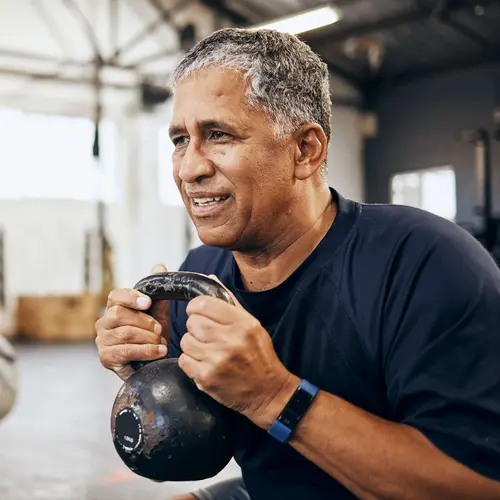How It Works
You won't be bored when you do circuit training. This workout gets your heart rate up and strengthens your muscles at the same time.
You’ll move quickly through 8-10 exercise stations to work different muscle groups with little to no rest between stations. Each station has a different exercise. You may do bicep curls or jump rope for 60 seconds.
You’ll do about 10-25 reps at each station, lasting between 30 seconds and 3 minutes, and then move on to the next station.
To keep things interesting, you can switch up the sequence, swap out different stations, and do it at the gym with equipment, at home with dumbbells and resistance bands, or on a fitness trail by alternating push-ups and squats with brisk walking or biking.
Allow at least 20-30 minutes for the workout. If you're new to the moves, work with a trainer or take a class so you learn how to do each exercise right.
Intensity Level: Medium
Push yourself as hard as you want. If you want to make it more challenging, switch from station to station faster or boost the intensity. Or you can work out at a more comfortable pace.
Areas It Targets
Core: Yes. Any station that engages your core, whether it’s a machine like the standing low cable hip abduction or an exercise like a front plank, can help you strengthen your core.
Arms: Yes. Use dumbbells for bicep curls and tricep extensions, or use gym equipment like triceps pushdowns or preacher curls.
Legs: Yes. Your legs will get a workout from gym machines like the seated leg press. For an extra boost, include intervals of squats or lunges in your circuit.
Glutes: Yes. Slip in any exercise that fires your glutes. At home or on a fitness trail, a station of lunges will do the trick. If you’re at the gym, opt for a machine like the lying hamstring curl machine.
Back: Yes. Use gym equipment like the seated machine row. At-home or on-trail moves like the front plank or pull-ups also target your back.
Type
Flexibility: Yes. Using proper technique as you work through your circuit will improve your flexibility.
Aerobic: Yes. Moving quickly through exercises makes this a good cardiovascular workout. If you include cardio stations like jumping rope, going up or down stairs, or jogging in place, you’ll get an added cardio boost.
Strength: Yes. Any station that involves strength training, like push-ups, dumbbells, or strength training machines, will make you stronger.
Sport: No, but if you're an athlete, circuit training is a great tool to improve your sports performance.
Low-Impact: Yes. You can choose low-impact exercises only.
What Else Should I Know?
Cost: It can be free if you use exercises that use your own body weight, like push-ups, planks, and lunges, or if you use equipment along a walking trail or a parcourse. If you do your circuits at the gym, you’ll pay gym membership fees.
Good for beginners? Yes. You can create your own circuit that’s right for you, even if you’re just starting out.
Outdoors: Yes. Try it on a fitness trail or your own backyard.
At home: Yes. Create stations out of exercises that use your own body weight, or use resistance bands, dumbbells, or kettlebells. Or try a DVD to guide you through a circuit-training workout.
Equipment required? No. You can choose exercises that use your own body weight. Or you can buy at-home equipment like dumbbells and resistance bands. If you belong to a gym, you can use the gym’s fitness machines.
What Dr. Michael Smith Says:
If you’re looking for a full-body workout in 30 minutes or less, circuit training does the trick. You get the benefits of muscle building and toning along with an intense cardio workout.
If you get bored trotting along on a treadmill or elliptical, circuit training can fix that, too. The exercise options are endless. Switch up the exercises frequently to tame the exercise doldrums and keep improving your body.
Work at your own pace. Start with a trainer one-on-one or in a small group setting to make sure you’re doing the exercises correctly and working within your limits.
Is It Good for Me If I Have a Health Condition?
Circuit training is an excellent option to help you lose weight along with a healthy diet. So if you need to lose weight because you have a condition like diabetes, high blood pressure, or high cholesterol, this may be a good choice for you.
It's intense, so check with your doctor first. You might be better off starting with something easier, especially if you have any heart problems.
If you have diabetes, make sure you know what to do if your blood sugar goes too low when exercising.
If you have arthritis, choose low-impact exercises. Don't do any moves that put pounding pressure on painful joints, like jumping jacks.
If you have a knee or back injury, circuit training isn’t for you. Once you’re recovered, it could be an option. Ask your doctor if you're ready for it. You may want to work with a physical therapist or certified trainer who can help you get the benefits while minimizing the risk of reinjury. If you're taking a class, let your instructor know about your injuries.
If you have other physical limitations, you can likely find something that works for you. An instructor or trainer can work with you to find moves that will still get your heart pumping and tone your muscles.
If you're pregnant and you did circuit training before getting pregnant, you can keep doing it if your doctor says it's OK. Drink water while you exercise, and don't do any exercises that could make you fall or get overheated.

